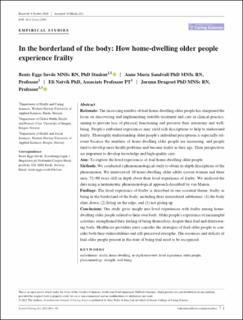| dc.contributor.author | Søvde, Bente Egge | |
| dc.contributor.author | Sandvoll, Anne Marie | |
| dc.contributor.author | Natvik, Eli | |
| dc.contributor.author | Drageset, Jorunn | |
| dc.date.accessioned | 2021-06-23T09:57:23Z | |
| dc.date.available | 2021-06-23T09:57:23Z | |
| dc.date.created | 2021-05-03T18:11:12Z | |
| dc.date.issued | 2021 | |
| dc.identifier.citation | Søvde, B. E., Sandvoll, A. M., Natvik, E., & Drageset, J. (2021). In the borderland of the body: How home‐dwelling older people experience frailty. Scandinavian Journal of Caring Sciences. | en_US |
| dc.identifier.issn | 0283-9318 | |
| dc.identifier.uri | https://hdl.handle.net/11250/2760812 | |
| dc.description.abstract | Rationale
The increasing number of frail home-dwelling older people has sharpened the focus on discovering and implementing suitable treatment and care in clinical practice, aiming to prevent loss of physical functioning and preserve their autonomy and well-being. People's embodied experiences may yield rich descriptions to help to understand frailty. Thoroughly understanding older people's individual perceptions is especially relevant because the numbers of home-dwelling older people are increasing, and people tend to develop more health problems and become frailer as they age. Their perspectives are important to develop knowledge and high-quality care.
Aim
To explore the lived experiences of frail home-dwelling older people.
Methods
We conducted a phenomenological study to obtain in-depth descriptions of the phenomenon. We interviewed 10 home-dwelling older adults (seven women and three men, 72–90 years old) in depth about their lived experience of frailty. We analysed the data using a hermeneutic phenomenological approach described by van Manen.
Findings
The lived experience of frailty is described in one essential theme: frailty as being in the borderland of the body, including three interrelated subthemes: (1) the body shuts down; (2) living on the edge; and (3) not giving up.
Conclusions
Our study gives insight into lived experiences with frailty among home-dwelling older people related to their own body. Older people's experience of meaningful activities strengthened their feeling of being themselves, despite their frail and deteriorating body. Healthcare providers must consider the strategies of frail older people to consider both their vulnerabilities and self-perceived strengths. The resources and deficits of frail older people present in the state of being frail need to be recognised. | en_US |
| dc.language.iso | eng | en_US |
| dc.publisher | Wiley | en_US |
| dc.rights | Attribution-NonCommercial-NoDerivatives 4.0 Internasjonal | * |
| dc.rights.uri | http://creativecommons.org/licenses/by-nc-nd/4.0/deed.no | * |
| dc.subject | embodiment | en_US |
| dc.subject | frailty | en_US |
| dc.subject | home-dwelling | en_US |
| dc.subject | in-depth interview | en_US |
| dc.subject | lived experience | en_US |
| dc.subject | older people | en_US |
| dc.subject | phenomenology | en_US |
| dc.subject | strength | en_US |
| dc.subject | well-being | en_US |
| dc.title | In the borderland of the body- how home dwelling older people experience frailty | en_US |
| dc.type | Peer reviewed | en_US |
| dc.type | Journal article | en_US |
| dc.description.version | publishedVersion | en_US |
| dc.rights.holder | © 2021 The Authors | en_US |
| dc.source.journal | Scandinavian Journal of Caring Sciences | en_US |
| dc.identifier.doi | 10.1111/scs.12984 | |
| dc.identifier.cristin | 1907857 | |
| cristin.ispublished | true | |
| cristin.fulltext | original | |
| cristin.qualitycode | 1 | |

